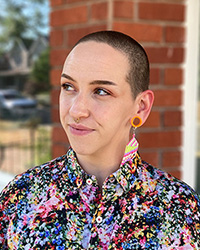Sheri Osden Nault
Creating a space for care, community, and experiments
By Busra Copuroglu
Sheri Osden Nault, a Métis visual artist and community activist, joined the Department of Visual Arts in 2022. As a multimedia artist whose work stretches across mediums including sculpture, performance, video, beading, and Indigenous tattoo revival, Nault’s work is informed by notions of care, entanglement, community, and human-nature relationships. They are now hoping to bring these principles to their classroom at Western. For Nault, it’s important that students talk to each other about their work, share their ideas, the challenges and dilemmas that they face, respond to each other’s work, and see this as part of the making process. “Being open and supportive of each other is also what they learn in my studio classes,” they said. “When I was doing my undergrad, professionalism was a category that you would be graded on, but I use ‘community’ as my word for that,” they added.
Nault’s classes combine technical and experimental tasks. In their Introduction to Drawing class, students both develop technical skills by working with a particular medium (like charcoal) and get to experiment with open ended assignments. In one of the assignments, for example, Nault asks them to select three lines from a poem or a song to create a drawing in response to those lines. “This allows them to explore meaning making in art and opens up symbolic possibilities,” they said.
In the classroom, Nault also tries to give the students a space to make mistakes. To that end, they created an evaluation system that doesn’t punish the student for trying something new and encourages them to challenge themselves and be experimental. “The criteria I work with are concepts, technical proficiency, ambition and experimentation, and how well it all works together,” they explained. In their drawing classes, for example, they want students to challenge themselves and go beyond merely drawing pristine lines and contours. “Some students may be drawing so well, but I want them to challenge themselves and experiment. If they try something new, they might fail in the drawing part, but they might do well on the concept, experimentation, and ambition parts of the rubric. So, it could all work well overall!” they said. “I’m trying to create a system where they are not punished for trying something new.”
New Course: Alternative Approaches to Creative Methods
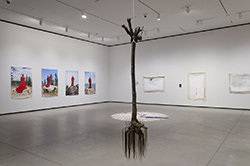 Next year, Nault will combine their teaching philosophy and art-making practice in the new course Alternative Approaches to Creative Methods, which will be open to students in different programs such as Curatorial Studies and Creative Arts and Production program (CAP). The course is designed to advance students’ methodological focuses on creative experimentation outside of what is familiar and comfortable. One of the assignments, for instance, will ask students to look at alternative material like garbage and waste, and other assignments ask students to experiment, for instance by asking students to make an artwork in a way they have been told they cannot make an artwork. The inspiration for this assignment comes from Nault’s experience in art schools. “When I was at school, and in one of my earlier teaching experiences, I had students of ethnic backgrounds where drawing anime, for example, was actually very relevant to them and their culture, but for a long time they were told ‘you cannot draw an anime or cartoons etc.’ It was like a rule,” they recalled. “So, when I started teaching, I let students do that and they did beautiful work, and it was culturally relevant to them. [This course] takes that one step further and breaks the rules of the process of making art,” they explained. “It's about doing and breaking the rules and seeing what comes out, because art should be experimental.”
Next year, Nault will combine their teaching philosophy and art-making practice in the new course Alternative Approaches to Creative Methods, which will be open to students in different programs such as Curatorial Studies and Creative Arts and Production program (CAP). The course is designed to advance students’ methodological focuses on creative experimentation outside of what is familiar and comfortable. One of the assignments, for instance, will ask students to look at alternative material like garbage and waste, and other assignments ask students to experiment, for instance by asking students to make an artwork in a way they have been told they cannot make an artwork. The inspiration for this assignment comes from Nault’s experience in art schools. “When I was at school, and in one of my earlier teaching experiences, I had students of ethnic backgrounds where drawing anime, for example, was actually very relevant to them and their culture, but for a long time they were told ‘you cannot draw an anime or cartoons etc.’ It was like a rule,” they recalled. “So, when I started teaching, I let students do that and they did beautiful work, and it was culturally relevant to them. [This course] takes that one step further and breaks the rules of the process of making art,” they explained. “It's about doing and breaking the rules and seeing what comes out, because art should be experimental.”
The Future and Change at Western
After working at various art institutions across Canada, Nault noted that they are impressed by the facilities at the John Labatt Visual Arts Centre. “Space sometimes can be limited in our field and art facilities here are really good with large, beautiful space for students to work in.” Aside from the facilities, Nault is also excited to see the development of new programs in the arts and humanities at Western. “I like how CAP sounds—it’s interesting to see the ebb and flow of programs starting and changing shape and I’m interested to see how that will continue to develop,” they said.
Nault also lauded the work of the Office of Indigenous Initiatives at Western “Generally, I’ve been pretty happy. The fact that the Collective Agreement for Indigenous faculty recognizes the service that we do for our community is very important. Community work takes a lot of time and energy. These things, to me, are very exciting about Western and they are not disconnected from creative components,” they remarked. Nault also wishes to see Western becoming a space that feels more welcoming to Indigenous students, especially with classroom spaces that encourage creativity and visibility.
Nault believes that change on university campuses comes with making space for a new generation faculty.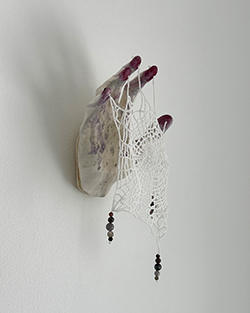 “Postsecondary education has largely been dominated by people who’ve held the same positions for a long time,” they said. “While some of them are fantastic, some of them are not putting in enough work and this is something I experienced in parts of my undergrad education,” they remarked. “I think institutions should recognize that they need new generation and a more diverse faculty, and with that, change comes inherently,” they said. “I have recently been through the struggles of being an emerging artist, trying to find any sense of stability, which is something the students are also going to be dealing with in the near future. We should give them insights into what’s that like now versus [what it was like] 20 years ago.”
“Postsecondary education has largely been dominated by people who’ve held the same positions for a long time,” they said. “While some of them are fantastic, some of them are not putting in enough work and this is something I experienced in parts of my undergrad education,” they remarked. “I think institutions should recognize that they need new generation and a more diverse faculty, and with that, change comes inherently,” they said. “I have recently been through the struggles of being an emerging artist, trying to find any sense of stability, which is something the students are also going to be dealing with in the near future. We should give them insights into what’s that like now versus [what it was like] 20 years ago.”
Though the life of a full-time artist without financial security may look daunting for many, uncertainty, for Nault, is not a reason to abandon passion and curiosity. “In the climate that we live in, the offer of studying anything and getting stability is unfortunately not a reality, and no matter what you study, you have to find ways to shape shift and make it work for you and respond to the ongoing changes in the climate of employment,” they said. “So, why wouldn’t you study art? You might as well do something you are passionate about.”
Gifts for Two-Spirit Youth
Alongside their artistic practices and teaching, Nault is also actively involved in a community-based initiative called Gifts for Two-Spirit to support Two-Spirit youth.
Nault started this initiative during the early days of the pandemic lockdowns in 2020, to address the concerns around how lockdowns and isolation would affect Indigenous and queer youth’s mental health and mobilized their online community on Instagram. Exchanging gifts with their friends inspired them prepare a few care packages to send to queer Indigenous youth. What started as a small project with the intention to prepare five care packages has later turned into a project of 50 care packages. “I have a lovely online community on my Instagram. So, I posted on my Instagram about this and wrote ‘do any settlers want to pitch any money to help me send out these packages?’ I was planning on preparing five packages, $15 each for shipping, and I just needed people to support. The outpouring of support was mind-blowing. So many people wanted to send money, and suddenly I had a $1,000 budget!” they said. Not long after, the project took on a life on its own. One of their friends volunteered to reach out to some organizations on their behalf for material donations, an Indigenous owned beauty brand, for example, agreed to donate, and community members made and donated beadwork. “Beadwork can be a powerful cultural signifiers for a lot of Indigenous youth who are feeling disconnected from the community,” Nault said.
The Google Form that Nault uses for gift bundle orders also ensures the safety of queer and Indigenous youth. “Not every queer and Indigenous youth can be fully themselves around their family and be living safely. So, I wanted to create a safe space and a community of care,” Nault said. “You don’t have to order this for yourself, for example, someone else can order this for you; you don’t have to put your name on it and have it delivered to someone else’s house.”
By February 2021, in the first year of the initiative, Nault sent out 25 gift bundles. In 2022 this number has doubled, and the initiative now has its own Instagram account. “Nobody is turned down,” Nault said. “You don’t have to prove why you deserve it; it’s not a scholarship. Indigenous community has unfortunately been subjected to colonial indoctrination to certain amounts of homophobia and transphobia, so youth at that intersection qualify immediately,” they remarked. The project, a fully community-oriented volunteer effort, is now entering its third year and it won’t end “just because we moved out of the lockdown phase of the pandemic,” Nault added.
Honoring the lives of Indigenous People
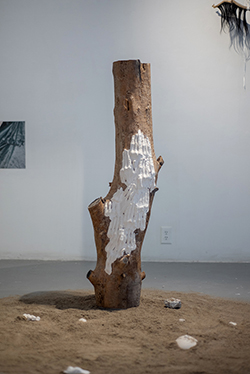 Growing up in Northern Alberta, since their teen years, Nault said they have always been involved in political and environmental activism, which is also mirrored in their work. Owing to chronic illness health issues, however, they have decided to step down from frontline roles and moved into support roles to “create resilience” and “give people a sense that they are loved, a reason to persist in a world that might feel incredibly hard.” “It’s important to honor that there are different roles people can play in activist communities,” they said. To this end, one of Nault’s long term projects addresses the ongoing police brutality against Indigenous folks in Canada. The work, Nault noted, requires a thorough research process. “There is no record kept of police involved Indigenous death in Canada. There is a database that CBC keeps of people who have died because of police actions, but it’s very limited. For example, if somebody dies in custody that’s not included. If somebody was in custody and released the next day and died, that’s not included,” they explained. To honor the names and lives of Indigenous People who have died at the hands of police and have long gone unnoticed, Nault is now building an archive and creating a beaded piece for each person whose name they find. Nault showed a part of this project in a group exhibition titled Hononga, which “connects an, as yet, unconnected group of Indigenous artists through their experience of indigeneity and creative practice,” in New Zealand in 2021.
Growing up in Northern Alberta, since their teen years, Nault said they have always been involved in political and environmental activism, which is also mirrored in their work. Owing to chronic illness health issues, however, they have decided to step down from frontline roles and moved into support roles to “create resilience” and “give people a sense that they are loved, a reason to persist in a world that might feel incredibly hard.” “It’s important to honor that there are different roles people can play in activist communities,” they said. To this end, one of Nault’s long term projects addresses the ongoing police brutality against Indigenous folks in Canada. The work, Nault noted, requires a thorough research process. “There is no record kept of police involved Indigenous death in Canada. There is a database that CBC keeps of people who have died because of police actions, but it’s very limited. For example, if somebody dies in custody that’s not included. If somebody was in custody and released the next day and died, that’s not included,” they explained. To honor the names and lives of Indigenous People who have died at the hands of police and have long gone unnoticed, Nault is now building an archive and creating a beaded piece for each person whose name they find. Nault showed a part of this project in a group exhibition titled Hononga, which “connects an, as yet, unconnected group of Indigenous artists through their experience of indigeneity and creative practice,” in New Zealand in 2021.
Nault has personal, familial connections to the project and grounding the project in their own experience is another important aspect for them. “I don’t want to be exploiting other people’s trauma to create something that might benefit me. I don’t think that’s OK,” they remarked. Based on the advice of knowledge keepers, community members, and a friend who worked on Walking with Our Sisters, a commemorative art installation project for the Missing and Murdered Indigenous Women of Canada and the United States, they set a seven-year trajectory for the project, which is a significant number to many Indigenous Communities.
Upcoming Projects
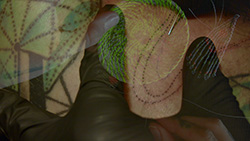 After many years of precarious and temporary positions, now as a full-time professor at Western Nault –contrary to what one might think— is looking forward to having more time to focus on their work and teaching. “Being a full-time artist without this faculty position meant a lot of precarity, which is true for many people in other fields, too” they remarked.
After many years of precarious and temporary positions, now as a full-time professor at Western Nault –contrary to what one might think— is looking forward to having more time to focus on their work and teaching. “Being a full-time artist without this faculty position meant a lot of precarity, which is true for many people in other fields, too” they remarked.
Indeed, Nault has several performances and exhibitions ahead of them. They will be part of a group exhibition in the ArtLab Gallery entitled of many worlds in this world, which will run from May 4 – June 8. The exhibition is curated by Ashar Mobeen, a Ph.D, student in Visual Arts, and will feature works by new faculty members, including Nault, Soheila Esfahani, and Jessica Karuhangae. Their short film maachi kashihtow has recently appeared in the Toronto Queer Film Festival. In mid-April this film will also be screened at the Images film festival in Toronto. In August, they will perform at London Ontario Media Arts Association (LOMAA)’s public sound art project called Resounding Peripheries. They will create an audio piece that relates to listening while walking near the river. They are also getting ready for a group exhibition in the Robert McLaughlin Gallery in Oshawa with other young, emerging Indigenous artists.
From environmental and political activism, to creating a community of care; from the struggles of an emerging artist to working to create inclusive classroom spaces, it seems Nault will keep offering us more entanglements, to, perhaps, help us make space for hope.
 About our Contributor
About our Contributor
Busra Copuroglu is a Ph.D. candidate in Comparative Literature with a background in French Studies. Her current doctoral dissertation, in progress, is about literary depictions of boredom and complaint from the late nineteenth century to the present.
Connect with Busra  Twitter
Twitter  LinkedIn
LinkedIn

